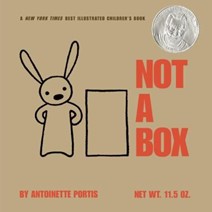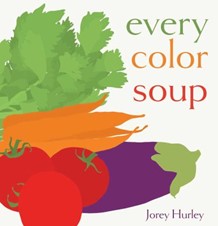Play Is Powerful!
By Kena Hardin, Children's Library Associate, Central Library
If you’ve taken your child to a Build A Reader storytime at one of the libraries, then you’ve certainly heard about the five activities children do every day that help them build reading skills. Talk, Sing, Read, Write, and Play! I recently learned about a term called “deep play” and how it differs from free play. For example, free play would be playing a card game like Go Fish. That is focusing on the act of play going on. Deep play focuses on the experience happening through free play. A couple ways that deep play differs from free play is when the experience is mentally absorbing and challenging or draws a connection to a player’s past (Dearybury and Jones 8). Deep play is the wonder that is experienced with play. Below are two examples of how deep play could be experienced along with books read with your child.
 Not A Box by Antoinette Portis is a fun story about a bunny who has a box, but the bunny insists that it simply is not a box! It is a rocket ship, a robot costume, a mountain, and more. Readers will be inspired to look at ordinary objects in a different light with the help of imagination! One way to play with your child is to save cardboard boxes and create something together, like that silly robot costume in the book! There are numerous, exciting toys for children made from plastic to natural materials, with screens or without, but the overlooked and ordinary objects in your household can be some of the best tools for you and your child to exercise creativity and bond over building together.
Not A Box by Antoinette Portis is a fun story about a bunny who has a box, but the bunny insists that it simply is not a box! It is a rocket ship, a robot costume, a mountain, and more. Readers will be inspired to look at ordinary objects in a different light with the help of imagination! One way to play with your child is to save cardboard boxes and create something together, like that silly robot costume in the book! There are numerous, exciting toys for children made from plastic to natural materials, with screens or without, but the overlooked and ordinary objects in your household can be some of the best tools for you and your child to exercise creativity and bond over building together.
 Every Color Soup by Jorey Hurley is a story that walks readers through the steps of making a soup. Children learn about sequences, colors, and following the steps of the recipe for the soup in the book. Children love to be involved in activities and encouraging them to make the soup together will not only be fun (and messy!) but beautiful memories will also be made. It goes beyond using wood or plastic toy food and pretending to make soup. Do you recall memories of cooking and baking in the kitchen with a parent, grandparent, siblings, etc.? Cooking isn’t necessarily play, but it can be used as an opportunity to still engage in deep play through the experience. Involvement in an activity, like cooking together, instills a sense of wonder that focuses on how we perceive our environment and how children develop background knowledge.
Every Color Soup by Jorey Hurley is a story that walks readers through the steps of making a soup. Children learn about sequences, colors, and following the steps of the recipe for the soup in the book. Children love to be involved in activities and encouraging them to make the soup together will not only be fun (and messy!) but beautiful memories will also be made. It goes beyond using wood or plastic toy food and pretending to make soup. Do you recall memories of cooking and baking in the kitchen with a parent, grandparent, siblings, etc.? Cooking isn’t necessarily play, but it can be used as an opportunity to still engage in deep play through the experience. Involvement in an activity, like cooking together, instills a sense of wonder that focuses on how we perceive our environment and how children develop background knowledge.
I encourage you to model for your child how to find wonder in play, to experience the meaning behind their play. “Find it, whisper it to them. Your eyes are wide, your voice is low. They’re leaning in... do you see it? Wonder is contagious” (19).
Work Cited:
Dearybury, Jed, and Julie P. Jones. The Playful Classroom: The Power of Play for All Ages. John Wiley and Sons, 2020.